Stock Markets Record Worst January Ever!
Stock-Markets / US Stock Markets Feb 01, 2009 - 07:06 AM GMTBy: Mike_Burk
 The good news is: Non existent. The S&P 500 (SPX) finished its worst January ever, down 8.57%.
The good news is: Non existent. The S&P 500 (SPX) finished its worst January ever, down 8.57%.
During the 1st year of the Presidential Cycle, since 1928, the SPX has been up 62% of the time, in January during the 1st year of the Presidential Cycle, with an average gain of 1.7%. Out of the 8 times the SPX has been down in January during the 1st year of the Presidential Cycle all but one turned out to be the beginning of a down year.
The table below shows every occurrence of a down January during the 1st year of the Presidential Cycle including the next month and full year performance.
Jan |
Feb |
Yr |
|
| 1941 | -3.9% | -0.8% | -17.9% |
| 1953 | -0.6% | -2.3% | -6.6% |
| 1957 | -3.2% | -3.0% | -14.3% |
| 1969 | -0.9% | -4.6% | -11.4% |
| 1973 | -2.6% | -2.7% | -17.4% |
| 1977 | -4.6% | -2.7% | -11.5% |
| 1981 | -5.0% | 3.4% | -9.7% |
| 2005 | -1.7% | 1.2% | 3.0% |
Short Term
After 4 consecutive down weeks the market is oversold.
As of last Wednesday the SPX managed to put in 4 consecutive up days for the 2nd time in the last 6 months then gave it all back Thursday and Friday.
4 consecutive days either way often defines a trend, but recently it has been just an oversold relief rally.
The chart below covers the past 6 months showing the SPX in red and an indicator showing the percentage of the last 4 trading days that have been up in black. The indicator touches the top of the chart when there have been 4 consecutive up days and it touches the bottom of the chart when there have been 4 consecutive down days. Dashed vertical lines have been drawn on the 1st trading day of each month.
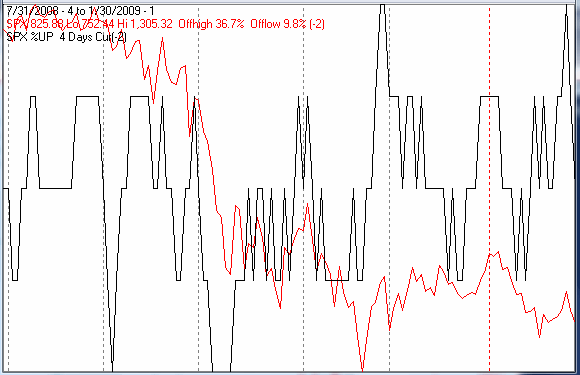
Intermediate term
New lows decreased last week, but remain relatively high.
In an up market new highs increase or remain high while new lows decrease or remain low. In a down market the opposite is true.
The chart below covers the past year showing the SPX in red and a 40% trend (4 day EMA) of NYSE new highs divided by new highs + new lows. Dashed vertical lines have been drawn on the 1st trading day of each month and dashed horizontal lines have been drawn at 10% levels for the indicator the horizontal line is solid at the 50% level.
The indicator fell below the 50% level in early May last year and has remained there except for a few days around the 1st of the year.
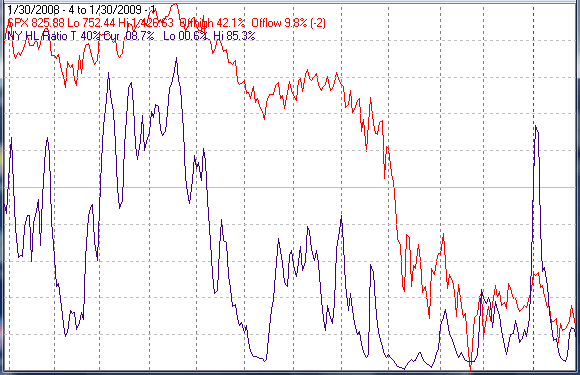
The chart below is similar to the one above except it covers the past 10 years to give you a perspective on how the indicator has worked over the longer term. Dashed vertical lines have been drawn on the 1st trading day of each year.
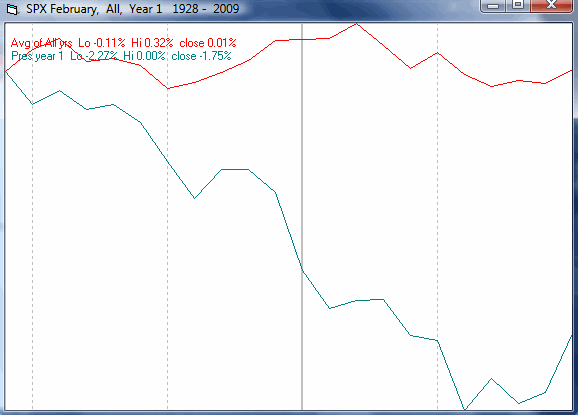
The next chart shows how the indicator worked around the 1987 crash.
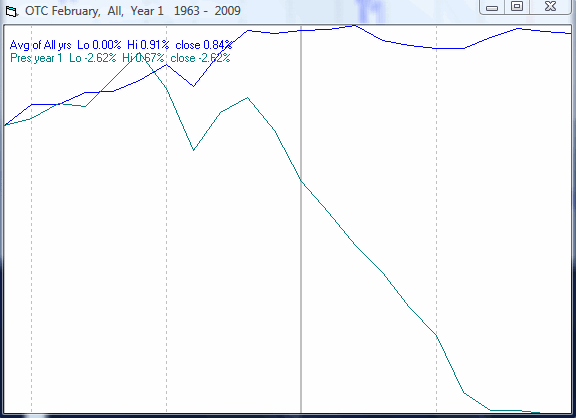
Last Wednesday there were only 12 new lows on the NYSE, but there were only 2 new highs. We will be in a bear market until the indicator can hold above the 50% level for more than a few days.
Seasonality
Next week includes the first 5 trading days of February during the 1st year of the Presidential Cycle.
The tables show the daily return on a percentage basis for the first 5 trading days of February during the 1st year of the Presidential Cycle. NASDAQ composite (OTC) data covers the period from 1963 - 2008 and SPX data from 1928 - 2008. There are summaries for both the 1st year of the Presidential Cycle and all years combined.
By most measures the returns have been positive for the period, but the draw downs have been extraordinarily large.
First 5 days of February.
The number following the year represents its position in the presidential cycle.
The number following the daily return represents the day of the week;
1 = Monday, 2 = Tuesday etc.
| OTC Presidential Year 1 | ||||||
| Day1 | Day2 | Day3 | Day4 | Day5 | Totals | |
| 1965-1 | 0.23% 1 | 0.15% 2 | 0.50% 3 | -0.08% 4 | 0.15% 5 | 0.95% |
| 1969-1 | 0.67% 1 | 0.01% 2 | 0.41% 3 | -0.24% 4 | 0.21% 5 | 1.06% |
| 1973-1 | 0.14% 4 | -1.14% 5 | -0.36% 1 | -0.38% 2 | 0.21% 3 | -1.52% |
| 1977-1 | 0.80% 2 | 0.17% 3 | -0.13% 4 | 0.43% 5 | -0.13% 1 | 1.12% |
| 1981-1 | -2.39% 1 | 0.24% 2 | 0.52% 3 | 0.88% 4 | 0.80% 5 | 0.07% |
| 1985-1 | -0.10% 5 | 0.84% 1 | 0.69% 2 | 0.62% 3 | 0.96% 4 | 3.02% |
| Avg | -0.18% | 0.02% | 0.23% | 0.26% | 0.41% | 0.75% |
| 1989-1 | 0.48% 3 | 0.48% 4 | 0.29% 5 | -0.09% 1 | 0.79% 2 | 1.95% |
| 1993-1 | 0.78% 1 | 0.48% 2 | 0.50% 3 | 0.03% 4 | -1.11% 5 | 0.68% |
| 1997-1 | -0.28% 1 | -0.17% 2 | -1.85% 3 | -0.15% 4 | 0.84% 5 | -1.60% |
| 2001-1 | 0.36% 4 | -4.39% 5 | -0.65% 1 | 0.81% 2 | -2.13% 3 | -6.00% |
| 2005-1 | 0.30% 2 | 0.31% 3 | -0.84% 4 | 1.41% 5 | -0.22% 1 | 0.96% |
| Avg | 0.33% | -0.66% | -0.51% | 0.40% | -0.37% | -0.80% |
| OTC summary for Presidential Year 1 1965 - 2005 | ||||||
| Averages | 0.09% | -0.28% | -0.08% | 0.29% | 0.03% | 0.06% |
| % Winners | 73% | 73% | 55% | 55% | 64% | 73% |
| MDD 2/7/2001 6.29% -- 2/6/1997 2.43% -- 2/2/1981 2.39% | ||||||
| OTC summary for all years 1963 - 2008 | ||||||
| Averages | 0.20% | -0.10% | 0.10% | 0.02% | 0.05% | 0.27% |
| % Winners | 67% | 67% | 58% | 59% | 63% | 63% |
| MDD 2/7/2002 7.86% -- 2/7/2001 6.29% -- 2/6/2008 5.58% | ||||||
| SPX Presidential Year 1 | ||||||
| Day1 | Day2 | Day3 | Day4 | Day5 | Totals | |
| 1929-1 | 0.39% 5 | -0.15% 6 | -0.62% 1 | 0.23% 2 | -0.82% 3 | -0.97% |
| 1933-1 | -3.89% 3 | -1.80% 4 | -0.31% 5 | -1.23% 6 | 0.47% 1 | -6.75% |
| 1937-1 | 0.28% 1 | 0.67% 2 | 0.72% 3 | 0.11% 4 | -1.60% 5 | 0.19% |
| 1941-1 | -0.70% 6 | -0.40% 1 | 0.10% 2 | 1.81% 3 | 0.39% 4 | 1.20% |
| 1945-1 | 0.22% 4 | 0.74% 5 | 0.37% 6 | 0.37% 1 | 0.22% 2 | 1.92% |
| Avg | -0.74% | -0.19% | 0.05% | 0.26% | -0.27% | -0.88% |
| 1949-1 | 0.79% 2 | 0.07% 3 | -0.20% 4 | -1.50% 5 | -1.59% 6 | -2.43% |
| 1953-1 | 0.49% 1 | 0.11% 2 | -0.45% 3 | -1.02% 4 | -1.30% 5 | -2.17% |
| 1957-1 | -0.22% 5 | -0.20% 1 | -1.44% 2 | -0.16% 3 | -0.46% 4 | -2.48% |
| 1961-1 | 0.19% 3 | 0.65% 4 | -0.13% 5 | -0.74% 1 | -0.18% 2 | -0.21% |
| 1965-1 | 0.02% 1 | -0.03% 2 | 0.09% 3 | -0.07% 4 | -0.32% 5 | -0.31% |
| Avg | 0.25% | 0.12% | -0.42% | -0.70% | -0.77% | -1.52% |
| 1969-1 | -0.12% 1 | 0.03% 2 | 0.27% 3 | 0.33% 4 | -0.01% 5 | 0.50% |
| 1973-1 | -1.09% 4 | -0.36% 5 | -0.10% 1 | 0.19% 2 | -0.69% 3 | -2.05% |
| 1977-1 | 0.50% 2 | -0.18% 3 | -0.50% 4 | 0.03% 5 | 0.01% 1 | -0.13% |
| 1981-1 | -2.04% 1 | 1.22% 2 | 0.10% 3 | 0.81% 4 | 0.75% 5 | 0.84% |
| 1985-1 | -0.56% 5 | 0.96% 1 | 0.14% 2 | -0.10% 3 | 0.77% 4 | 1.22% |
| Avg | -0.66% | 0.34% | -0.02% | 0.25% | 0.17% | 0.08% |
| 1989-1 | -0.13% 3 | -0.08% 4 | 0.04% 5 | -0.31% 1 | 1.21% 2 | 0.73% |
| 1993-1 | 0.85% 1 | 0.01% 2 | 1.05% 3 | 0.53% 4 | -0.14% 5 | 2.30% |
| 1997-1 | 0.07% 1 | 0.32% 2 | -1.39% 3 | 0.24% 4 | 1.21% 5 | 0.45% |
| 2001-1 | 0.55% 4 | -1.75% 5 | 0.36% 1 | -0.15% 2 | -0.84% 3 | -1.83% |
| 2005-1 | 0.69% 2 | 0.32% 3 | -0.28% 4 | 1.10% 5 | -0.11% 1 | 1.73% |
| Avg | 0.41% | -0.24% | -0.04% | 0.28% | 0.27% | 0.67% |
| SPX summary for Presidential Year 1 1929 - 2005 | ||||||
| Averages | -0.18% | 0.01% | -0.11% | 0.02% | -0.15% | -0.41% |
| % Winners | 60% | 55% | 50% | 55% | 40% | 50% |
| MDD 2/4/1933 7.06% -- 2/5/1949 3.26% -- 2/6/1953 2.75% | ||||||
| SPX summary for all years 1928 - 2008 | ||||||
| Averages | 0.16% | 0.05% | -0.15% | 0.02% | -0.05% | 0.02% |
| % Winners | 63% | 59% | 47% | 50% | 50% | 63% |
| MDD 2/4/1933 7.06% -- 2/5/1932 5.47% -- 2/3/1938 5.05% | ||||||
Money Supply
The chart below was provided by Gordon Harms. Money supply has exploded far above its elevated trend of the past 2 years. Money growth of this magnitude would normally push the market higher.
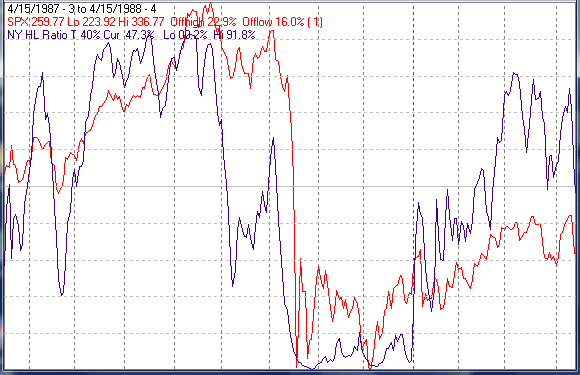
February
Since 1963 the OTC has been up 52% of the time in February with an average gain of 0.1% making it one of the worst months of the year. During the 1st year of the Presidential Cycle the OTC has only been up 27% of the time with an average loss of 3.8% making it the worst month of the entire 4 year Presidential Cycle. The 3.8% average loss was enhanced considerably by a 22.7% loss in 2001.
The average month has 21 trading days. The chart below has been calculated by averaging the daily percentage change of the OTC for each of the 1st 11 trading days and each of the last 10. In months when there were more than 21 trading days some of the days in the middle were not counted. In months when there were less than 21 trading days some of the days in the middle of the month were counted twice. Dashed vertical lines have been drawn after the 1st trading day and at 5 trading day intervals after that. The line is solid on the 11th trading day, the dividing point.
The blue line shows the average of all years since 1963 while the green line shows the average during the 1st year of the Presidential Cycle.
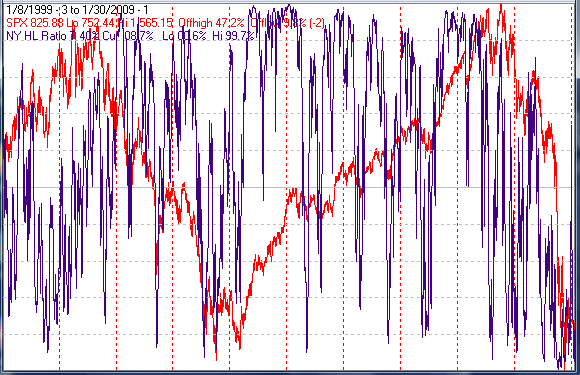
Since 1928 the SPX has been up 52% of the time in February with an average loss of 0.3% making it second to September as the worst month of the year. During the 1st year of the Presidential Cycle the SPX has only been up 40% of the time with an average loss of 1.7% making it second to September again as the worst month of the entire 4 year Presidential Cycle.
The chart below is similar to the one above except it shows the SPX for all years in red and the 1st year of the Presidential Cycle in green.
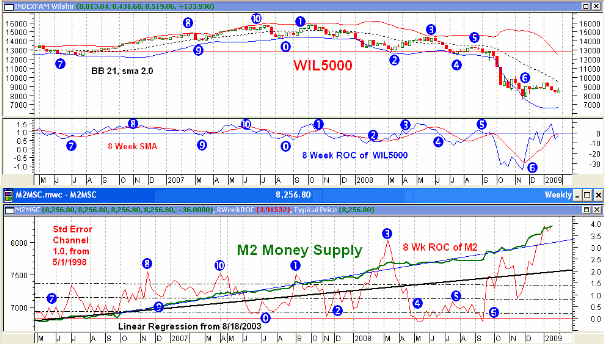
Conclusion
The market appears to be hopeless. In spite of exploding money supply and a deeply oversold condition, it continues to fall. Seasonally we are entering one of the worst months of the entire 4 year Presidential Cycle.
I expect the major indices to be lower on Friday February 6 than they were on Friday January 30.
This report is free to anyone who wants it, so please tell your friends. They can sign up at: http://alphaim.net/signup.html . If it is not for you, reply with REMOVE in the subject line.
Last weeks positive forecast was a miss.
Thank you,
By Mike Burk
To subscribe to this report : http://alphaim.net/signup.html
Gordon Harms produces a Power Point for our local timing group. You can get a copy of that at: http://www.stockmarket-ta.com/ .
Disclaimer: Mike Burk is an employee and principal of Alpha Investment Management (Alpha) a registered investment advisor. Charts and figures presented herein are believed to be reliable but we cannot attest to their accuracy. Recent (last 10-15 yrs.) data has been supplied by CSI (csidata.com), FastTrack (fasttrack.net), Quotes Plus (qp2.com) and the Wall Street Journal (wsj.com). Historical data is from Barron's and ISI price books. The views expressed are provided for information purposes only and should not be construed in any way as investment advice. Furthermore, the opinions expressed may change without notice.
Mike Burk Archive |
© 2005-2022 http://www.MarketOracle.co.uk - The Market Oracle is a FREE Daily Financial Markets Analysis & Forecasting online publication.



